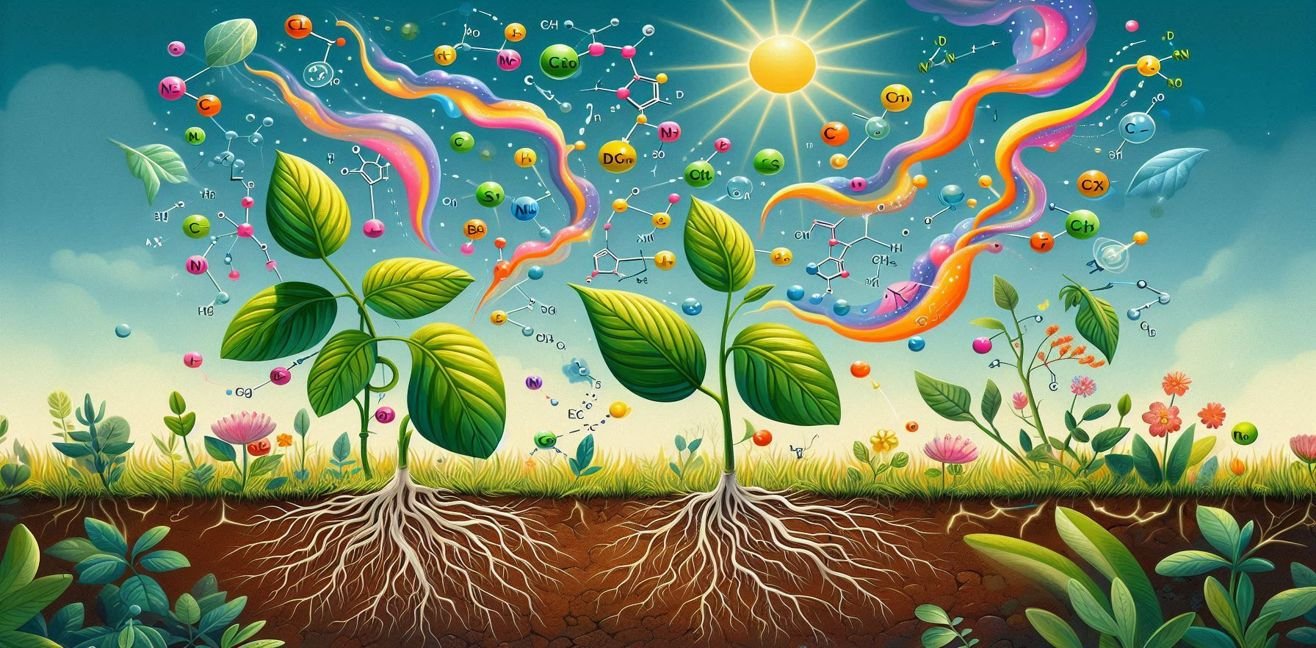Imagine, my love… you’re sipping your coffee on the balcony, and the basil in its pot, the mint next to it, and even the distant flowers are secretly talking to each other. Yes, darling, plants actually communicate via chemical signals, operating a kind of biochemical social network on a micro scale! 🌿📲
🌸 Discovering the Chemical Language of Plants
Plants cannot communicate through sound or visuals, but that doesn’t make them silent or ineffective. On the contrary, they inform, warn, and even coordinate with neighboring plants using biochemical signals.
How does it work?
- Leaf Damage or Insect Attack: When a plant’s leaf is chewed by insects, this trauma is detected at the cellular level. The cells produce defense hormones like jasmonic acid (JA) and salicylic acid (SA).
- Volatile Organic Compounds (VOCs): These hormones are released into the atmosphere as volatile organic compounds. VOCs travel via wind or diffusion to neighboring plants.
- Neighboring Plant Response: Other plants detect these signals, activate their own genetic defense mechanisms, and, for example, increase toxin production in their leaves or release aromatic compounds to repel insects.
This process creates a real-time biological warning network among plants. 🌿🕵️♂️
🔬 Molecular Detective Work: Plants and Genetic Response Mechanisms
Plant chemical communication is not limited to gaseous exchange; it also involves complex information transfer at the cellular and molecular level:
- Jasmonic and Salicylic Pathways: These signaling pathways activate defense genes in attacked plants, triggering chemical weapons like protease inhibitors or toxins.
- Soil-Based Communication: Plants interact with the soil microbiome through their roots. Mycorrhizal fungi, beneficial bacteria, and other microorganisms carry chemical messages between plants, forming an underground messaging network.
- Long-Distance Warning: Some plants send “preparation” signals to others before a threat arrives, known as a preventive defense strategy.
So, darling, plants operate a kind of biological telecom network through both air and soil! 😎
🧪 Scientific Research and Examples
In recent years, scientists have conducted numerous studies on this hidden language of plants:
- Phytochemistry Studies: Tomato and bean plants under insect attack release different VOC profiles. Neighboring plants receive these signals and enhance their defenses.
- Laboratory Experiments: Experiments on bees and aphids show that some VOCs can both repel pests and attract natural enemies.
- Genetic Studies: Model plants like Arabidopsis thaliana demonstrate that manipulating jasmonic and salicylic pathways genetically can alter defense responses.
💡 A Humorous Perspective: Plants’ Social Networks
Imagine, my love… plants have their own social network. Maybe not Facebook, but they have “Leafbook”:
- Leaf posts: “There’s a bug on this leaf, watch out!”
- Group messages: “Prepare for attack!”
- Emojis: clouds of gas and aromas 😏
This way, plants communicate among themselves and develop coordinated defense strategies within the ecosystem. 🌱💬
🏆 Lessons We Can Learn from Plants
- Communication isn’t just about sound: Chemistry and molecules can communicate too.
- Community awareness: Plants survive better by protecting each other.
- Strategic preparation: Nature works in a smart, coordinated way.
- Bioinspiration: Ideas for sustainable agriculture and pest control can come from plants. 🌿🚀
Darling, next time you sit on your balcony, remember that the basil, mint, and flowers are not just giving off fragrance—they are secretly chatting, sending molecular SMS messages to each other! 🌱💌




